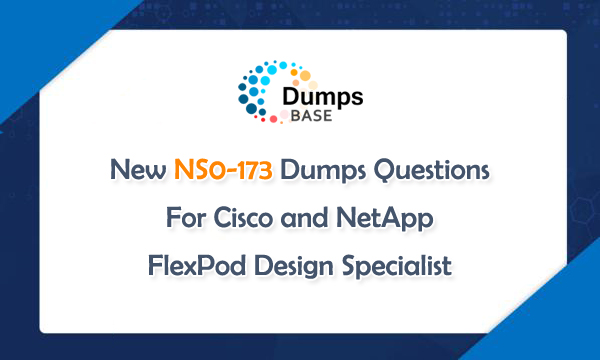New NS0-173 Dumps Questions For Cisco and NetApp FlexPod Design Specialist
How to prepare for NS0-173 Cisco and NetApp FlexPod Certification exam? DumpsBase provide the high-quality NS0-173 Dumps Questions that will help you to be Cisco and NetApp FlexPod Design Specialist and have complete NS0-173 Dumps Questions for you to learn about the questions of Cisco and NetApp FlexPod Certification. DumpsBase NS0-173 Dumps Questions are cracked by the professional team, who have rich experience in NetApp certification. Network Appliance NS0-173 dumps questions include a 100% passing guarantee that can boost your preparation for NetApp NS0-173 exam and you'll be able to pass NS0-173 exam without any difficulties.

Cisco and NetApp FlexPod Design Specialist NS0-173 Exam Is Available
You are proficient in designing and installing FlexPod solutions for a variety of business workloads. FlexPod solutions speed the deployment of infrastructure and business-critical applications while reducing cost, complexity, and risk.
NetApp offers two Cisco and NetApp FlexPod certifications: FlexPod Design Specialist and FlexPod Implementation and Administration Specialist.
FlexPod logos and certificates will be granted to those individuals who successfully pass either of the following:
Cisco and NetApp FlexPod Design (NS0-173) certification exam.
Cisco and NetApp FlexPod Implementation and Administration (NS0-174) certification exam.
NS0-173 exam includes 60 test questions, with an allotted time of 60 minutes to complete. In countries where English is not the native language, candidates for whom English is not their first language will be granted a 30-minute extension to the allotted examination completion time.
The NS0-173 exam covers the following topics:
Compute
Hardware components
Configuration
High availability
SAN Boot
UCS Manager
Networking
Hardware components
Configuration
High availability
SAN Boot
Storage
Hardware components
Configuration
High availability
SAN Boot
Virtualization
Hypervisor Solutions
SAN Boot
Design, Management, and Orchestration Tools
Cisco and NetApp FlexPod Design Specialist NS0-173 Free Dumps Online
We have verified that the most updated NS0-173 exam dumps are valid for your Cisco and NetApp FlexPod Design Specialist Certification. Most candidates would like to check NS0-173 free dumps before getting the full version. Here, we will share NS0-173 free demo online.
A customer is planning to deploy a FlexPod solution for a large scale SAN requirement that uses the FC protocol. The customer plans to use Smart Zoning in the configurations to reduce the number of TCAM entries in the zoning process.
In this scenario, which design would enable the customer to use Smart Zoning?
A. storage connected to Cisco Nexus 9000 Series switches
B. storage connected to Cisco Nexus 5000 Series switches
C. storage connected to Cisco MDS switches
D. storage directly connected to Cisco UCS Fabric Interconnects
Answer: C
What are characteristics of the Cisco UCS 5108 blade chassis?
A. 4 RU, 6 half-width UCS B-Series blades, 160 Gbps I/O bandwidth
B. 6 RU, 8 half-width UCS B-series blades, 160 Gbps I/O bandwidth
C. 6 RU, 6 half-width UCS B-series blades, 80 Gbps I/O bandwidth
D. 4 RU, 8 half-width UCS B-series blades, 40 Gbps I/O bandwidth
Answer: B
A customer is evaluating management tools for a new FlexPod infrastructure. They desire a tool that can orchestrate the provisioning of UCS compute nodes, NetApp storage, and VMware networking.
Which tool satisfies the requirements of this customer's heterogeneous environment?
A. UCS Central
B. NetApp OnCommand Unified Manager
C. NetApp OnCommand Insight
D. UCS Director
Answer: D
You are configuring a FlexPod system for NAS protocols. You want to ensure that there are multiple paths between the initiators and targets in the solution.
Which two steps will accomplish this task? (Choose two.)
A. Allow the VLANs over the vPC peer link.
B. Configure the VLANs in Cisco UCS Manager as Common/Global.
C. Disable LACP.
D. Configure the VSANs in the Cisco Nexus 5000 switches.
Answer: B,C
When FCoE is configured in a FlexPod environment, which step is required?
A. Assign a VLAN to the FC Uplink port on the Cisco Fabric Interconnects.
B. Create a VSAN within service profiles.
C. Create a VSAN to support FCoE for the FC uplink.
D. Assign a VSAN to the server uplink port on the Cisco Fabric Interconnects.
Answer: D
The storage administrator must change the vHBA settings bound to a template associated with a production server.
What happens when the settings are reconfigured in this scenario?
A. The vHBA configuration change does not affect LUN access.
B. The server that is associated with the service profile reboots.
C. The service profile template that is associated with the server is initialized.
D. The vHBA template is deleted from UCS Manager.
Answer: C
Which command would a FlexPod administrator use to determine whether an FC initiator has logged on to the fabric?
A. MDS9148>show fcfwd
B. MDS9148>show fcdomain
C. MDS9148>show fcc
D. MDS9148>show flogi database
Answer: D
A customer recently configured its Cisco UCS, and within the Chassis Discovery policy, they set the link group preference to Port Channel.
Which two benefits would they derive from this link group preference? (Choose two.)
A. All the links between the Cisco Fabric Interconnects and chassis IOM are shared.
B. Each blade has an assigned Cisco Fabric Interconnects link.
C. All the links between the Cisco Fabric Interconnects and chassis IOM are pinned.
D. Traffic is load balanced across the links.
Answer: A,D
